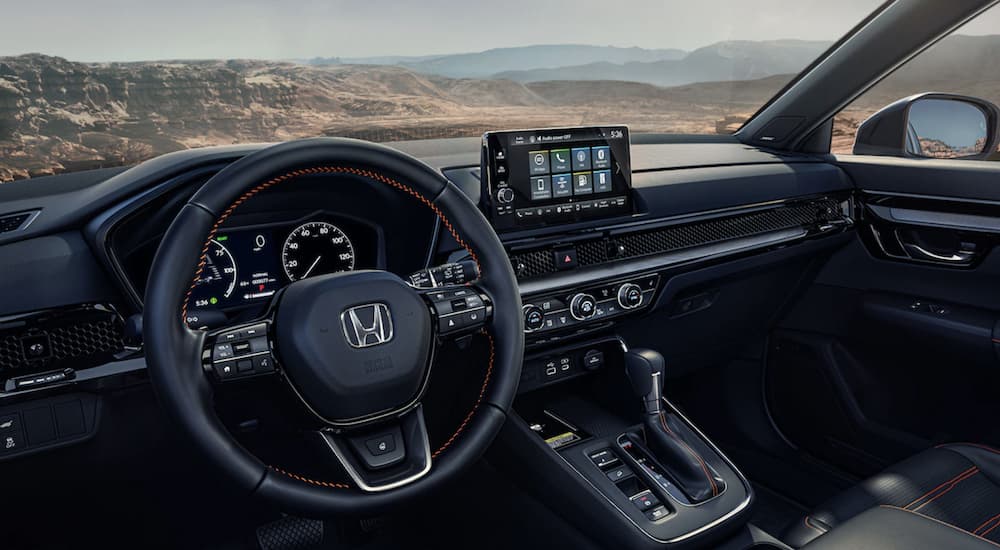The Honda Accord has been around for seemingly a lifetime. It was first introduced to the world all the way back in 1977 to fill a gap in the market for larger sedans. Up until that point, Honda had been predominantly a motorcycle and minicar company. In 1995, Honda announced that a new vehicle would enter its lineup, the Honda CR-V. It was to be built on the same platform and with the same powertrain options as the already popular Accord, but the body style would be different.
The CR-V was an early entrant into the rapidly growing compact SUV market and remains a staple vehicle for many families to this day. It’s easy to find a Honda CR-V for sale, both new and used, all across the country. But what exactly are the differences between the Honda Accord and the Honda CR-V, given that their inner workings are so similar? We’ll take a closer look at some of the pros and cons between these two vehicles to parse out the differences.
Interior and Exterior Dimensions
Even though the Accord and the CR-V are built on the same platform, they do vary slightly in size. For example, the Accord is slightly longer than the CR-V, which is taller and has more ground clearance than the Accord. For the 2024 models of these vehicles, the Accord is 195.7 inches long, while the CR-V is 184.8 inches. For height, the Accord stands 57.1 inches tall, and the CR-V reaches up to 66.5 inches. The difference in width is negligible at just 0.2 inches in favor of the CR-V.
Both vehicles can comfortably fit up to five passengers, so the size of your family shouldn’t matter when comparing them. Depending on your personal preference, you might want the greater headroom that the CR-V offers or the more spacious legroom of the Accord. There is an extra inch of front legroom in the Accord because, unlike the CR-V, it hasn’t prioritized cargo space.
Cargo Room
One of the main selling points of Honda’s compact SUV is the spacious cargo hold of the CR-V. Its SUV design creates a whopping 39.3 cu.ft. of storage area with the seats up. An added benefit of the SUV design is the ability for drivers to fold down the rear seats to create a larger area for loading cargo. This totals 76.5 cu.ft. in the 2024 model. The Accord doesn’t have as much standard space in its truck as the CR-V does in the back, but you can still fold the seats down to create more cargo room in the same way you can in the CR-V. Still, if you want to haul a lot of stuff, the CR-V wins that battle any day.
Fuel Efficiency
The Accord, being a sedan, is closer to the ground and designed to be more aerodynamic than the CR-V. As such, it’s not surprising that the Accord gets better fuel economy ratings than the CR-V despite having the same powertrain options. In the 2024 Accord, for example, you can expect to get 32 MPG combined. That decreases to 30 MPG combined in front-wheel drive Honda CR-V models. This is a decrease, but the Honda CR-V still ranks highly for fuel economy compared with other compact SUVs in its class.
Both of these vehicles also come with the choice of an optional hybrid powertrain. This uses electric motors to give the gasoline engine a boost in terms of both power and efficiency. With the hybrid powertrain, the 2024 Accord gets an estimated 48 MPG combined, whereas the CR-V only gets 40 MPG combined with front-wheel drive. That’s a much more substantial difference than between the traditional gasoline options, again thanks to the more efficient sedan design of the Accord.
Drivetrain Options
You might have noticed how we mentioned MPG in terms of front-wheel drive for the CR-V. That’s because the Honda CR-V is available with all-wheel drive for either engine option. The Honda Accord only comes in front-wheel drive. This is plenty adequate for folks who are predominantly going to be using their vehicle for regular road driving. If you drive on backroads, do any amount of off-roading, or just want that extra bit of traction when the weather is bad, the CR-V will be best able to fill that need for you. The trade-off of choosing all-wheel drive is that fuel efficiency goes down slightly to compensate for the added mechanical inefficiency of powering all four wheels.
Towing
Another capability that is only available on the CR-V and not on the Accord is the ability to tow. The 2024 CR-V is capable of towing up to 1,500 lbs with its base engine or 1,000 lbs with its hybrid option. This means you can bring along a small trailer with your sporting or outdoor equipment when you hit the road for adventure. Even though the power these two vehicles create is similar, only the CR-V has a body engineered to withstand towing. Additionally, the all-wheel drive configuration helps increase traction and stability, both necessities for towing.
Infotainment
The Accord is the slightly sportier vehicle of the two, and Honda puts more emphasis on keeping that vibe going throughout the cabin. As such, drivers who purchase a new Honda Accord can upgrade the standard seven-inch digital infotainment screen to a 12.3-inch display. On the CR-V, the standard screen can only be upgraded to a nine-inch screen, which is still plenty for many people. Both the Accord and the CR-V come standard with Apple CarPlay and Android Auto on the newer models. You can even upgrade these connections to wireless on either vehicle on higher trim levels.
Starting Prices
The price of a new Honda Accord or Honda CR-V plays a major factor in most people’s decision-making process. Both vehicles are good financial investments that retain their value well over the long term. However, the Honda Accord will ring up at the register with a lower starting price. A new 2024 Honda Accord is priced at $27,895 for the base trim. A new 2024 Honda CR-V, on the other hand, is priced at $29,500. This is because of the additional capability and larger overall body (and, therefore, the materials used) in the CR-V. Leasees and folks with monthly loan payments might find that the routine cost of driving one of these vehicles is similar enough that other factors might take precedence over cost savings. Of course, fuel efficiency will also play an important role in overall cost calculations and should be factored into budgets.
Is There a Winner?
Overall, both of these vehicles have a lot to offer potential drivers. Despite being built on the same platform with the same powertrain options, there are some significant differences. The biggest pros we found for the CR-V were its ability to haul significant cargo and traverse rough terrain successfully. The main pros of the Accord were its spacious and comfortable interior and better fuel efficiency. However, there certainly isn’t a winner in terms of which vehicle is better than the other. It all depends on the lifestyle the driver lives and how they’re planning to use their Honda. If you need something to haul camping equipment and hit backroads, you might want to look for a Honda CR-V for sale. If you’re an individual commuting to the office, the Accord might make more sense for you.






